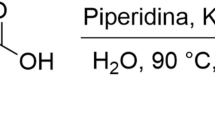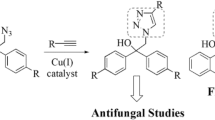Abstract
Antifungal effectivity and utility of cinnamaldehyde is limited because of its high MIC and skin sensitivity. In this study, α-methyl trans cinnamaldehyde, a less irritating derivative, have been self coupled and complexed with Co(II) and Ni(II) to generate N, N′–Bis (α-methyl trans cinnamadehyde) ethylenediimine [C22H24N2], [Co(C44H48N4)Cl2] and [Ni(C44H48N4)Cl2]. Ligand and complexes were characterized on the basis of FTIR, ESI–MS, IR and 1HNMR techniques. Synthesized ligand [L] and complexes were investigated for their MICs, inhibition of ergosterol biosynthesis and H+ extrusion against three strains of Candida: C. albicans 44829, C. tropicalis 750 and C. krusei 6258. Average of three species MIC of methyl cinnamaldehyde is 317 μg/ml (2168 μM). Compared to methyl cinnamaldehyde ligand [L], Co(II) and Ni(II) complex are found to be 4.48, 17.78 and 21.46 times more effective in liquid medium and 2.73, 8.93 and 10.38 times more effective in solid medium. At their respective MIC90 average inhibition of ergosterol biosynthesis caused by methyl cinnamaldehyde, ligand [L], Co(II) and Ni(II) complex, respectively was 80, 78, 90 and 93%. H+ extrusion was also significantly inhibited but did not co-relate well with MIC90. Results indicate ergosterol biosynthesis as site of action of α-methyl cinnamaldehyde, synthesized ligand and complexes. α-methyl cinnamaldehyde and ligand did not show any toxicity against H9c2 rat cardiac myoblast cell, whereas Co(II) and Ni(II) complexes on an average produced 19% cellular toxicity.





Similar content being viewed by others
References
Ahmad A, Khan A, Manzoor N, Khan LA (2010) Evolution of ergosterol biosynthesis inhibitors as fungicidal against Candida. Microb Pathog 48:35–41
Arthington SBA, Jradi H, Desai T, Morrison CJ (1999) Quantification of ergosterol content: novel method for determination of fluconazole susceptibility of Candida albicans. J Clin Microbiol 37:3332–3337
Bang KH, Lee DW, Park HM, Rhee YH (2000) Inhibition of fungal cell wall synthesizing enzymes by trans-cinnamaldehyde. Biosci Biotechnol Biochem 64:1061–1063
Ben-Josef AM, Manavathu EK, Platt D, Sobel JD (2000) Proton translocating ATPase mediated fungicidal activity of a novel complex carbohydrate: CAN-296. Int J Antimicro Agents 13:287–295
Chaudhary A, Singh RV (2004) Synthetic, Spectroscopic and toxicological aspects of novel eighteen to twenty two membered tetraaza macrocycles and their bivalent manganese complexes. Indian J Chem 43:2529–2535
Cheng SS, Liu J, Chang E, Chang ST (2008) Antifungal activity of cinnamaldehyde and Eugenol congeners against wood-rot fungi. Biores Tech 99:5145–5149
Chohan ZH, Pervez H, Rauf A, Khan KM, Supuran CT (2004) Isatins-derived antibacterial and antifungal compounds and their transition metal complexes. J Enz Inhib Med Chem 19:417–423
Elias KM, Jonathan RD, Sarvesh CV, Chandrasekar PH (2001) Inhibition of H+-ATPase- mediated proton pumping in Cryptococcus neoformans by a novel conjugated Styryl ketone. J. Antimicrob Chemother 47:491–494
Gill AO, Holley RA (2004) Mechanisms of bactericidal action of cinnamaldehyde against Listeria monocytogenes and of eugenol against L. monocytogenes and Lactobacillus sakei. Appl Biochem Biotechnol 70:5750–5755
Gupta AK, Thomas E (2003) New antifungal agents. Dermatol Clin 2:565–576
Gupta MK, Neelakantan TV, Sanghamitra M, Tyagi RK, Dinda A, Mualik S, Mukhopadhyay CK, Goswami SK (2006) An assessment of the role of reactive oxygen species and redox signaling in norepinephrine-induced apoptosis and hypertrophy of H9c2 cardiac myoblasts. Antioxid Redox Signal 8:1081–1093
Kemp W (1975) Organic spectroscopy. Macmillan Press Ltd, London
Khalaji AD, Weil M (2007) Crystal structure of N, N′- Bis (trans-cinnamaldehyde) ethylenediimine. Anal Sci 2:187–188
Kohli A, Smriti, Mukhopadhyay K, Rattan A, Prasad R (2002) In vitro low-level resistance to azoles in Candida albicans is associated with changes in membrane lipid fluidity and asymmetry. Antimicrob Agents Chemother 46:1046–1052
Kwon JA, Yu CB, Park HD (2003) Bacterial effects and inhibition of cell separation of cinnamic aldehyde on B. cereus. Lett Appl Microbiol 37:61–65
Nakamoto K (1970) Infrared spectra of inorganic and coordination compounds. Wiley Interscience, New York
Nguyen MH, Peacock JE, Morris AJ Jr, Tanner DC, Nguyen ML, Snydman DR, Wagener MM, Rinaldi MG, Yu VL (1996) The changing face of candidemia: emergence of non-Candida albicans species and antifungal resistance. Am J Med 100:617–623
Odds FC, Brown AJ, Gow NA (2003) Antifungal agents: mechanisms of action. Trends Microbiol 11:272–279
Ooi LS, Li Y, Kam SL, Wang H, Wong EY, Ooi VE (2006) Antimicrobial activities of cinnamon oil and cinnamaldehyde from the Chinese medicinal herb Cinnamomum cassia Blume. Am J Chin Med 34:511–522
Pfaller MA, Jones RN, Messer SA, Edmond MB, Wenzel RP (1998) National surveillance of nosocomial blood stream infection due to species of Candida other than Candida albicans: frequency of occurrence and antifungal susceptibility in the SCOPE Program. Diagn Microbiol Infect Dis 30:121–129
Rashid B, Manzoor N, Amin M, Khan LA (2004) Effect of glucose, its analogs and some amino acids on Pre-steady state kinetics of ATP hydrolysis by PM-ATPase of pathogenic yeast C. albicans. Korean J Biol Sci 8:307–312
Serrano R (1980) Effect of ATPase inhibitors on the proton pump of respiratory deficient yeast. Eur J Biochem 105:419–424
Sheikh S, Sheikh RA, Bhatia R, Hashmi AA, Manzoor N, Khan LA (2010) Anticandidal activity of cinnamaldehyde, its ligand and Ni (II) complex: effect of increase in ring and side chain. Microb Pathog 49:75–82
Shimokawa O, Nakayama H (1992) Increased sensitivity of Candida albicans cells accumulating 14 alpha- methylated sterols to active oxygen: possible relevance to in vivo efficacies of azole antifungal agents. Antimicrob Agents Chemother 36:1626–1629
Vimala AM, Raymond RS (1997) Mechanism of cinnamaldehyde sensitization. Contact Dermat 3:16–18
Walsh SE, Mailard JY, Russell AD, Catrenich CE, Charbonneau DL, Bartolo RG (2003) Activity and mechanism of selected biocidal agents on Gram-positive and negative bacteria. J Appl Microbiol 94:240–247
Wang SY, Chen PF, Chang ST (2005) Antifungal activities of essential oils and their constituents from indigenous cinnamon (Cinnamomum osmophloeum) leaves against wood decay fungi. Biores Tech 96:813–818
Acknowledgments
Sheikh Shreaz greatly acknowledges the financial support by ICMR (India) grant 45/93/09-Pha/BMS, (S.R.F). The authors are thankful to Dr. Inshad A. Khan, Scientist E1, BSL-3 Lab, I·I.I.M Canal road Jammu, India, for providing standard Candida species. Authors are also indebted to Shageer Ahmad from Department of Biosciences J.M.I (India) for providing valuable technical assistance.
Author information
Authors and Affiliations
Corresponding author
Rights and permissions
About this article
Cite this article
Shreaz, S., Sheikh, R.A., Bhatia, R. et al. Antifungal activity of α-methyl trans cinnamaldehyde, its ligand and metal complexes: promising growth and ergosterol inhibitors. Biometals 24, 923–933 (2011). https://doi.org/10.1007/s10534-011-9447-0
Received:
Accepted:
Published:
Issue Date:
DOI: https://doi.org/10.1007/s10534-011-9447-0




